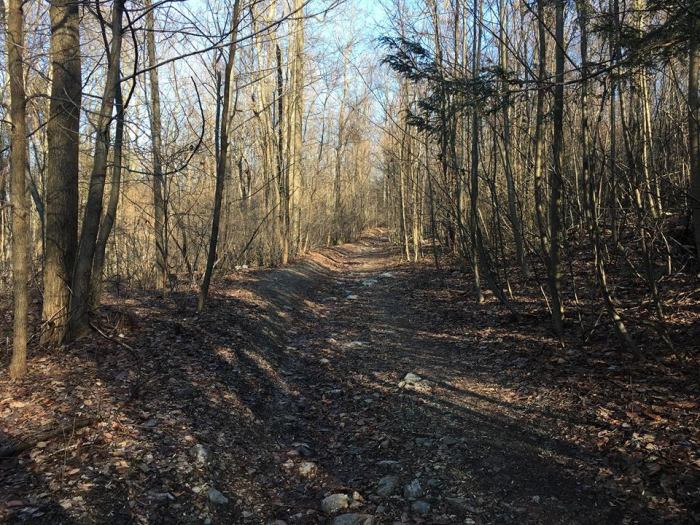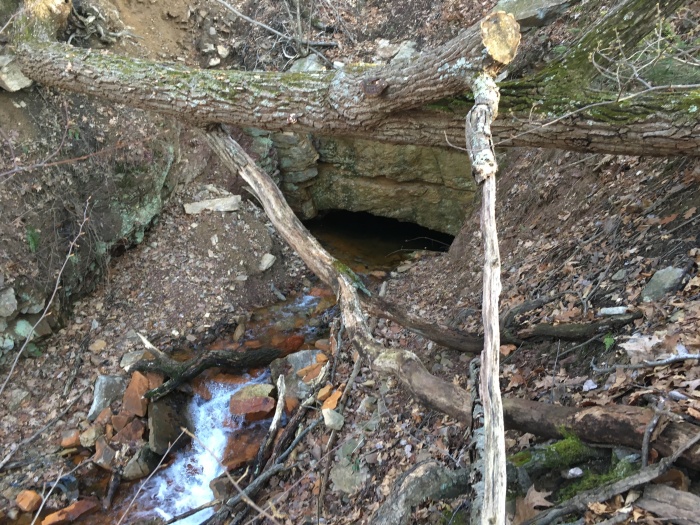On the day before Christmas Eve, my father and I made a quick trek to the very eastern end of Williams Valley for a visit to the former site of the Kalmia Colliery.
Today, little remains of this once bustling coal mining operation in Tremont Township, on the southwestern border of Schuylkill County, that produced millions of tons of coal and supported a company-owned village of several hundred people. Aside from coal banks and a landscape scarred by mining, only the slightest depressions where almost two dozens homes, a company store, a school, and other buildings once stood.
The Kalmia Colliery was first opened in 1869 by John Phillips and William Sheafer, with mining operations commencing in 1870. Shortly thereafter, the colliery suffered its first casualty. Miner Daniel Herb died while working in the Kalmia Tunnel and left behind a wife and 7 children. In the 1870s, Phillips and Sheafer were bought out by the Philadelphia and Reading Coal and Iron Company, but continued on as operators.
By 1880, the town had 30 homes and a population of 231 people. By 1886, however, the mine was rapidly being worked out and operations to remove “pillars” began. Once this work began, with no new operations being undertaken, the death of Kalmia had begun. By 1887, the P&R closed the Kalmia Colliery and evicted the workers from their homes. Some buildings were subsequently taken apart and moved elsewhere or the materials were sold. In the 130 years since the colliery’s closure, nature has taken back the town of Kalmia.
The following images and descriptions tell the story of our brief visit to Kalmia on a brisk, but otherwise beautiful December afternoon.


Modern view looking east along Kalmia’s single street. The road is rough, though is still accessible to four-wheel drive vehicles. Little evidence remains that there once was a thriving village here.


This is an 1870s view of Kalmia’s main street looking east with houses and other buildings. Along this stretch, more than 200 people lived. Kalmia had little in the way of social activities, with only one school house. Because this village was company owned and operated, no saloons or drinking establishments were permitted. The town did have a baseball club that played throughout the 1880s.

Little remains today along the main street in Kalmia. This photograph, looking west, shows the intersection where Kalmia Road enters Kalmia. A company store and the operator’s house stood near this crossroads in the 1870s.

Another view from the eastern limits of Kalmia looking west. On the southern side of the street (left), depressions remain from the miners’ homes that existed here from 1870-1887.

On the level above the town exists the remnants of the coal mining operation. Very little remains due to decay and erosion. This series of stone walls and foundations once made up part of Kalmia’s first coal breaker, where coal was processed and separated for sale. A new breaker was added later in the 1870s, which stood adjacent to this site. Erosion has completely destroyed the site of the newer breaker.

This 1870s view of the Kalmia Colliery’s breakers shows the two breakers where coal was processed before shipping. Breaker No. 2 is the old breaker site, photographed above. The site of Breaker No. 1 has been destroyed by the mine drainage from the Kalmia Tunnel.

The remains of the Kalmia Tunnel which was completed in 1870-71. The tunnel reached back 170 yards to the Lykens Valley vein of anthracite coal. The tunnel was located just above Breaker No. 1, where coal could be easily dumped for processing by the colliery’s 40 outside employees.

Another view of the Kalmia Tunnel showing the considerable mine drainage that has thoroughly destroyed the site of Breaker No. 1.

The view the tunnel level out across Williams Valley. The communities in the distance are Orwin and Tower City.

This 1877 view shows Breaker No. 1 and the view across Williams Valley to the collieries at West Brookside (Tower City) and Williamstown, several mines west in Dauphin County.
Our interest in the story of Kalmia Colliery and its village has been piqued by this visit and future posts will continue to explore the history of Williams Valley’s forgotten patch town.
Featured Image: The view of Williams Valley from the coal banks above Kalmia.
Wow, this is pretty awesome. For such a small town that wasn’t around for very long, I’m surprised there were so many period drawings and maps done of Kalmia!
LikeLiked by 1 person
Love seeing the history of the Lykens valley, Schuykill , Northumberland, Dauphin Counties. Thanks for thr lessons in history.
Marlene Simpson
LikeLiked by 1 person
Very interesting read! I had ancestors leave the collieries of Whitehaven England for Schuylkill County in the 1850’s. Well done
LikeLiked by 1 person
Thank you for this beautiful remembetance of our county’s history
LikeLiked by 1 person
Interesting, well done story. Amazing then and now pictures.
LikeLiked by 1 person
My cousin and I would love to explore this site. Our ancestors loved in Kalmia.
These pictures are amazing! How could we find this site?
LikeLike
Good story and pictures. Thanks for this. It is amazing what nature can reclaim, erasing evidence of a community except for some small clues and, of course, the scars of coal mine operations. I assume the name Kalmia comes from the plant family that includes Mountain Laurel. Any ideas where the name Orwin – the village in the distance – got its current name?
LikeLiked by 1 person
This was an awesome story. My son has a mine up on the Williams town mountain, and still mines coal to this present day. I always like to see the old anthracite stories. Thank you so much.⛏⚒
LikeLiked by 1 person
Really interesting! Daniel Herb was my daughter’s 3x great grandfather.
LikeLike